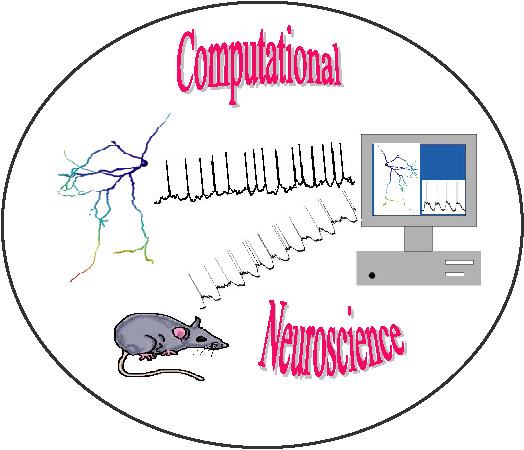

The basal ganglia form a set of interconnected nuclei in the forebrain. Overall the basal ganglia receive a large amount of input from cerebral cortex, and after processing, send it back to cerebral cortex via thalamus. This major pathway led to the creation of the popular concept of cortico-basal ganglia-cortical loops. Inside the basal ganglia there are too many connections and pathways to cover in this paragraph. Just briefly: The cortex sends excitatory input to the striatum. The principle neuron of the striatum is the famous medium spiny neuron, which sends its inhibitory output on to the globus pallidus. The globus pallidus can also be excited by cortical activity, namely by a pathway that travels through the subthalamic nucleus first. The globus pallidus is really divided into two segments, only one of which sends output (yet again inhibitory!) to the thalamus and on to cortex, thus completing the loop. The larger segment of globus pallidus (GPe) just inhibits the subthalamic nucleus and itself. The functional significance of this connection is still quite mysterious! Similar to the cerebellum the basal ganglia are also implicated in learning, and the system that is thought to be important here is the dopaminergic input received from the Substantia nigra pars compacta. Probably the best known fact regarding the basal ganglia is that a lesion of this dopaminergic pathway causes Parkinson’s disease.
Physiology:
Numerous research projects have recorded electrical activity in the basal ganglia. Unfortunately for the experimentalists seeking clear answers, the recorded activity in behaving animals can be related just about to any component of sensory input, motor preparation, and movement execution. One thing is sure however: The medium spiny neurons are active only at a very slow rate, and furthermore the connection to the GP takes more time than most pathways in the brain. In contrast to cerebellum this system seems unsuitable for the fast feedback control of ongoing movement. Neurons in GP in contrast are active at a very high rate. This could be very useful, if both decreases and increases in activity need to be communicated accurately to the thalamus. Since GP neurons are inhibitory in thalamus, a decrease in activity actually would disinhibit the thalamus, and thus activate cortex. Single cell properties of various cell types in the basal ganglia are also quite unique and interesting, and intracellular recordings in brain slices and anesthetized animals have showed how specific features of single neuron properties could be important in the ongoing function of the basal ganglia.
Function:
As is true for the cerebellum, the ultimate answers about the exact function of the basal ganglia in the control of behavior have yet to be established. One very good candidate is called “Action Selection Hypothesis”. In this model the basal ganglia would be the arbiter of which of the potential actions that cortex might be planning actually gets executed. This fits together well with the idea that dopamine is a system mediating learning based on reward. This could train the basal ganglia to chose behaviors that have been rewarding in the past. The overall lack of action found in Parkinsons’ disease is also easily reconciled with the idea of action selection. The other major symptom, namely movement tremor, however, is not. The presence of movement tremor and other specific motor problems, have led some people to believe that the basal ganglia may play a role in the planning and coordination of specific movement sequences. Thus, the temporal sequencing of movements is another intriguing function of the basal ganglia.
Basal Ganglia Overview Chapter and Review Article Selection:
Albin RL, Young AB, and Penney JB. 1989. The functional anatomy of basal
ganglia disorders. Trends.Neurosci. 12:366-375.
Albin RL, Young AB, and Penney JB. 1995. The functional anatomy of
disorders of the basal ganglia. [Review] [11 refs]. Trends in Neurosciences
18:63-4.
Alexander GE and Crutcher MD. 1990. Functional architecture of basal
ganglia circuits: neural substrates of parallel processing. Trends.Neurosci.
13:266-271.
Beiser DG, Hua SE, and Houk JC. 1997. Network models of the basal ganglia.
[Review] [38 refs]. Current Opinion in Neurobiology 7:185-90.
Chesselet MF and Delfs JM. 1996. Basal ganglia and movement disorders:
an update. [Review] [50 refs]. Trends in Neurosciences 19:417-22.
Redgrave P, Prescott TJ, and Gurney K. 1999. The basal ganglia:
A vertebrate solution to the selection problem? Neuroscience 89:1009-1023.
Schultz W and Dickinson A. 2000. Neuronal coding of prediction errors.
Annu.Rev.Neurosci. 23:473-500.
Waelti P, Dickinson A, and Schultz W. 2001. Dopamine responses comply
with basic assumptions of formal learning theory. Nature 412:43-48.
Wichmann T and DeLong MR. 1996. Functional and pathophysiological models
of the basal ganglia. [Review] [90 refs]. Current Opinion in Neurobiology
6:751-8.